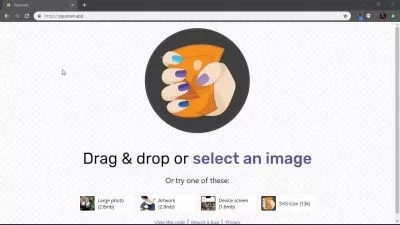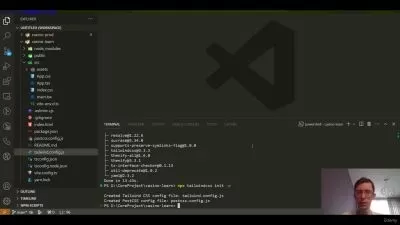Build a Frontend Web Framework (From Scratch), Video Edition
Focused View
7:34:25
0 View
001. Part 1. No framework.mp4
01:08
002. Chapter 1. Are frontend frameworks magic to you.mp4
06:16
003. Chapter 1. The framework we ll build.mp4
07:52
004. Chapter 1. Overview of how a frontend framework works.mp4
20:36
005. Chapter 1. Summary.mp4
01:05
006. Chapter 2. Vanilla JavaScript like in the old days.mp4
06:00
007. Chapter 2. Writing the application.mp4
21:29
008. Chapter 2. Summary.mp4
00:34
009. Part 2. A basic framework.mp4
01:54
010. Chapter 3. Rendering and the virtual DOM.mp4
05:38
011. Chapter 3. The virtual DOM.mp4
06:04
012. Chapter 3. Getting ready.mp4
00:54
013. Chapter 3. Types of nodes.mp4
01:27
014. Chapter 3. Element nodes.mp4
06:09
015. Chapter 3. Text nodes.mp4
00:38
016. Chapter 3. Fragment nodes.mp4
04:01
017. Chapter 3. Components The cornerstone of frontend frameworks.mp4
10:19
018. Chapter 3. Summary.mp4
01:56
019. Chapter 4. Mounting and destroying the virtual DOM.mp4
26:49
020. Chapter 4. Destroying the DOM.mp4
06:14
021. Chapter 4. Summary.mp4
00:23
022. Chapter 5. State management and the application s lifecycle.mp4
26:16
023. Chapter 5. Assembling the state manager into the framework.mp4
10:14
024. Chapter 5. Summary.mp4
00:52
025. Chapter 6. Publishing and using your framework s first version.mp4
04:05
026. Chapter 6. A short example.mp4
02:21
027. Chapter 6. Refactoring the TODOs app.mp4
11:30
028. Chapter 6. Summary.mp4
00:44
029. Chapter 7. The reconciliation algorithm Diffing virtual trees.mp4
06:35
030. Chapter 7. Comparing two virtual DOM trees.mp4
10:00
031. Chapter 7. Changes in the rendering.mp4
02:48
032. Chapter 7. Diffing objects.mp4
03:01
033. Chapter 7. Diffing arrays.mp4
02:36
034. Chapter 7. Diffing arrays as a sequence of operations.mp4
24:38
035. Chapter 7. Summary.mp4
00:33
036. Chapter 8. The reconciliation algorithm Patching the DOM.mp4
09:17
037. Chapter 8. Patching the DOM.mp4
33:28
038. Chapter 8. Publishing the framework s new version.mp4
00:51
039. Chapter 8. The TODOs application.mp4
05:39
040. Chapter 8. Summary.mp4
01:45
041. Part 3. Improving the framework.mp4
01:27
042. Chapter 9. Stateful components.mp4
12:43
043. Chapter 9. Components as classes.mp4
04:19
044. Chapter 9. Components with state.mp4
14:50
045. Chapter 9. Summary.mp4
00:47
046. Chapter 10. Component methods.mp4
07:37
047. Chapter 10. Binding event handlers to the component.mp4
01:45
048. Chapter 10. Mounting the DOM with a host component.mp4
01:46
049. Chapter 10. Patching the DOM with a host component.mp4
03:25
050. Chapter 10. Summary.mp4
00:34
051. Chapter 11. Subcomponents Communication via props and events.mp4
22:03
052. Chapter 11. Events.mp4
13:23
053. Chapter 11. Summary.mp4
00:42
054. Chapter 12. Keyed lists.mp4
11:09
055. Chapter 12. Extending the solution to element nodes.mp4
06:23
056. Chapter 12. Using the key attribute.mp4
05:39
057. Chapter 12. The application instance.mp4
02:08
058. Chapter 12. Publishing the framework.mp4
01:02
059. Chapter 12. Summary.mp4
00:41
060. Chapter 13. The component lifecycle hooks and the scheduler.mp4
07:04
061. Chapter 13. Implementing the mounted and unmounted lifecycle hooks.mp4
02:56
062. Chapter 13. The scheduler.mp4
16:00
063. Chapter 13. Publishing version 4 of the framework.mp4
01:00
064. Chapter 13. Summary.mp4
00:55
065. Chapter 14. Testing asynchronous components.mp4
13:12
066. Chapter 14. Publishing version 4.1 of the framework.mp4
01:02
067. Chapter 14. Where to go from here.mp4
04:46
068. Chapter 14. Summary.mp4
00:28
More details
User Reviews
Rating
average 0
Focused display
Category

Udemy
View courses UdemyStudents take courses primarily to improve job-related skills.Some courses generate credit toward technical certification. Udemy has made a special effort to attract corporate trainers seeking to create coursework for employees of their company.
- language english
- Training sessions 68
- duration 7:34:25
- Release Date 2024/11/03








